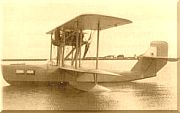| CANT 10 | |
|---|---|
 | |
| General information | |
| Type | Flying boat airliner |
| Manufacturer | CANT |
| Designer | |
| Number built | 18 |
| History | |
| First flight | 1925 |
The CANT 10 was a flying boat airliner produced in Italy in the 1920s. It was a conventional biplane design with single-bay, unstaggered wings of equal span, having seating for four passengers within the hull, while the pilot sat in an open cockpit. The engine was mounted in pusher configuration in the interplane gap.